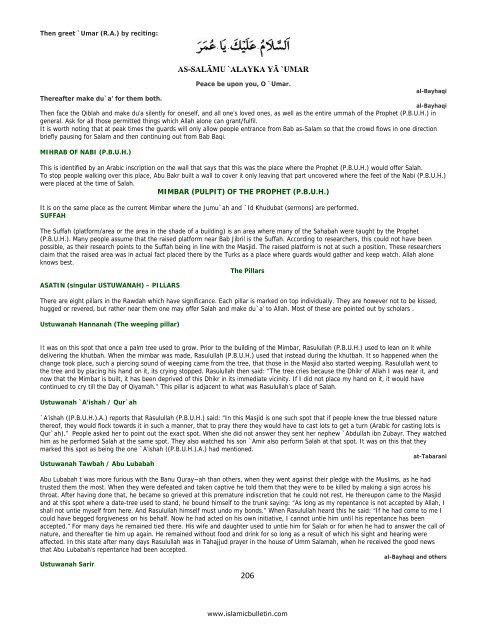You also want an ePaper? Increase the reach of your titles
YUMPU automatically turns print PDFs into web optimized ePapers that Google loves.
Then greet `Umar (R.A.) by reciting:<br />
Peace be upon you, O `Umar.<br />
al-Bay<strong>haq</strong>i<br />
Thereafter make du`a’ for them both.<br />
al-Bay<strong>haq</strong>i<br />
Then face the Qiblah and make du’a silently for oneself, and all one’s loved ones, as well as the entire ummah of the Prophet (P.B.U.H.) in<br />
general. Ask for all those permitted things which Allah alone can grant/fulfil.<br />
It is worth noting that at peak times the guards will only allow people entrance from Bab as-Salam so that the crowd flows in one direction<br />
briefly pausing for Salam and then continuing out from Bab Baqi.<br />
MIHRAB OF NABI (P.B.U.H.)<br />
This is identified by an Arabic inscription on the wall that says that this was the place where the Prophet (P.B.U.H.) would offer Salah.<br />
To stop people walking over this place, Abu Bakr built a wall to cover it only leaving that part uncovered where the feet of the Nabi (P.B.U.H.)<br />
were placed at the time of Salah.<br />
MIMBAR (PULPIT) OF THE PROPHET (P.B.U.H.)<br />
It is on the same place as the current Mimbar where the Jumu`ah and `Id Khudubat (sermons) are performed.<br />
SUFFAH<br />
The Suffah (platform/area or the area in the shade of a building) is an area where many of the Sahabah were taught by the Prophet<br />
(P.B.U.H.). Many people assume that the raised platform near Bab Jibril is the Suffah. According to researchers, this could not have been<br />
possible, as their research points to the Suffah being in line with the Masjid. The raised platform is not at such a position. These researchers<br />
claim that the raised area was in actual fact placed there by the Turks as a place where guards would gather and keep watch. Allah alone<br />
knows best.<br />
The Pillars<br />
ASATIN (singular USTUWANAH) – PILLARS<br />
There are eight pillars in the Rawdah which have significance. Each pillar is marked on top individually. They are however not to be kissed,<br />
hugged or revered, but rather near them one may offer Salah and make du`a’ to Allah. Most of these are pointed out by scholars .<br />
Ustuwanah Hannanah (The weeping pillar)<br />
It was on this spot that once a palm tree used to grow. Prior to the building of the Mimbar, Rasulullah (P.B.U.H.) used to lean on it while<br />
delivering the khutbah. When the mimbar was made, Rasulullah (P.B.U.H.) used that instead during the khutbah. It so happened when the<br />
change took place, such a piercing sound of weeping came from the tree, that those in the Masjid also started weeping. Rasulullah went to<br />
the tree and by placing his hand on it, its crying stopped. Rasulullah then said: “The tree cries because the Dhikr of Allah I was near it, and<br />
now that the Mimbar is built, it has been deprived of this Dhikr in its immediate vicinity. If I did not place my hand on it, it would have<br />
continued to cry till the Day of Qiyamah.” This pillar is adjacent to what was Rasulullah’s place of Salah.<br />
Ustuwanah `A’ishah / Qur`ah<br />
`A’ishah ((P.B.U.H.).A.) reports that Rasulullah (P.B.U.H.) said: “In this Masjid is one such spot that if people knew the true blessed nature<br />
thereof, they would flock towards it in such a manner, that to pray there they would have to cast lots to get a turn (Arabic for casting lots is<br />
Qur`ah).” People asked her to point out the exact spot. When she did not answer they sent her nephew `Abdullah ibn Zubayr. They watched<br />
him as he performed Salah at the same spot. They also watched his son `Amir also perform Salah at that spot. It was on this that they<br />
marked this spot as being the one `A’ishah ((P.B.U.H.).A.) had mentioned.<br />
at-Tabarani<br />
Ustuwanah Tawbah / Abu Lubabah<br />
Abu Lubabah t was more furious with the Banu Quray~ah than others, when they went against their pledge with the Muslims, as he had<br />
trusted them the most. When they were defeated and taken captive he told them that they were to be killed by making a sign across his<br />
throat. After having done that, he became so grieved at this premature indiscretion that he could not rest. He thereupon came to the Masjid<br />
and at this spot where a date-tree used to stand, he bound himself to the trunk saying: “As long as my repentance is not accepted by Allah, I<br />
shall not untie myself from here. And Rasulullah himself must undo my bonds.” When Rasulullah heard this he said: “If he had come to me I<br />
could have begged forgiveness on his behalf. Now he had acted on his own initiative, I cannot untie him until his repentance has been<br />
accepted.” For many days he remained tied there. His wife and daughter used to untie him for Salah or for when he had to answer the call of<br />
nature, and thereafter tie him up again. He remained without food and drink for so long as a result of which his sight and hearing were<br />
affected. In this state after many days Rasulullah was in Tahajjud prayer in the house of Umm Salamah, when he received the good news<br />
that Abu Lubabah’s repentance had been accepted.<br />
al-Bay<strong>haq</strong>i and others<br />
Ustuwanah Sarir<br />
206<br />
www.islamicbulletin.com


